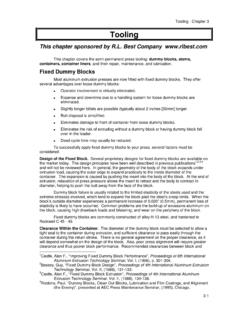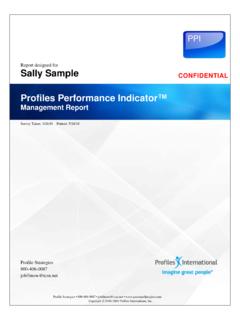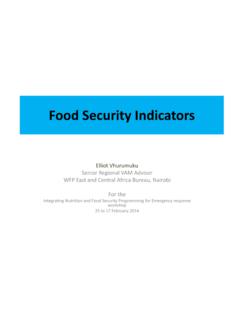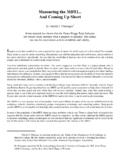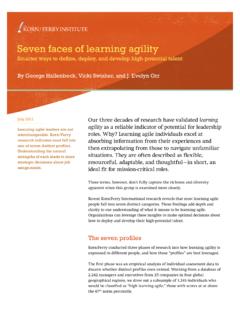Transcription of Age Ovens - Aluminum extrusion press …
1 Age Ovens - Chapter 9 9-1 Age OvensAge OvensAge OvensAge Ovens This chapter is available for sponsorship. For information contact The Ageing1 Process Approximately 60-70% of the extrusions sold in the US and perhaps worldwide are from the alloy family 6063/6060/6061/6005A. These alloys are heat treatable, meaning that it is possible to retain the magnesium silicide in a solid solution with a suitable quenching mechanism at the press and then precipitate the magnesium silicide in a controlled fashion in an ageing oven at an elevated temperature. This mechanism is referred to as age hardening and it is a necessary step to achieve desired mechanical properties such as ultimate and yield strengths and The ageing process requires maintaining the profiles at a precise temperature for a specific time, according to standard Time-Temperature-Transformation curves for each alloy and temper.
2 Instead of measuring and controlling actual profile temperature, under proper conditions the age oven may be controlled from air temperature if the location for measuring the air temperature is chosen correctly. It is also necessary to know the relationship between the air and profile temperatures, as well as how temperatures vary throughout the oven. If the profile temperature is not uniform within the oven, profile quality will be unpredictable -- perhaps some under-aged or over-aged, or both conditions occurring within the same load. Temperature Surveys To insure temperature consistency and predictability, it is important to conduct periodic surveys.
3 Methods vary: extruders producing high performance alloys, for example for Military applications, are required to survey at least weekly in order to certify the heat treatment used. Many others, however, never conduct surveys and have no idea of the actual ageing recipe being followed; for these, quality is left to chance. Keep in mind that readings of Webster hardness are at best a very poor indicator of age oven operation. Instead, quarterly temperature surveys are recommended to control quality performance. Procedure for Oven Surveys. A multi-point temperature device is required, typically with 24 or more recording points.
4 A multi-point temperature recorder with strip chart is commonly used; another option is to use a notebook computer fitted with a thermocouple interface device. Mr. Ram Ramanan3 used a Toshiba personal computer (with) Multiple I-O plexer interface. Data gathered via PC is more easily collected, analyzed, and stored. 1 Is it ageing or aging ? We prefer the former and use it throughout this manual, but according to the dictionary either spelling is correct. 2 Ramanan, Ram, How to Obtain the Most from Your Ageing Ovens , Proceedings of 6th International Aluminum extrusion Technology Seminar, (1996).
5 3 Ibid. Figure 9-1: Typical age oven Age Ovens - Chapter 9 9-2 Next prepare a map of the oven, selecting and numbering the locations to be measured. The goal is to find and measure the hottest and coldest profile temperatures at various points in the oven. The coldest ones tend to be downstream of the load, and/or isolated from the air flow, for example near the center of the load. The hottest points will be upstream, and directly exposed to the incoming air flow, for example at the exterior of the load. Attach the thermocouples to the profiles using heat resistant tape.
6 See notes on thermocouples on Page xix at the front of this Manual. Loading the oven If air by-passes the load to any degree, heat transfer will be reduced, cycle time will be longer, and there will be a decrease in fuel efficiency and temperature uniformity. Therefore the first goal in loading the oven is to minimize hot air by-pass and to maximize the air flow through the load. If possible, horizontal spacers should allow space between layers to promote flow through the load (Figure 9-2); this is especially critical with cross-flow age Ovens . Excess space on the sides, top and bottom of the load should be reduced to the minimum required for clearance when loading and unloading the oven.
7 Baffles constructed of sheet steel may be installed for this purpose; they may be temporary or permanent. Partially-loaded containers of profiles may also allow by-passing. If full loads are not possible, a system of temporary baffle plates may be needed, to block the by-passing and force the air through the load. Finally, the heaviest profiles in a given load should be located upstream so that they contact the hottest air. The heavy profiles require longer to heat up, so this manner of loading will tend to even out the profile temperature. Basic Age Oven Configurations Age Ovens are built in various designs, according to performance requirements and individual preferences.
8 However, most age Ovens have the following basic design; for multi-zone Ovens , each zone has the same elements. Work Chamber. The section of the age oven where the profiles are loaded to be aged. Some means for loading and unloading containers of profiles is usually included, for example a work cart, conveyors, or tracks located on the floor. Age oven floors are sometimes insulated but often are not. Air Distribution Ducts or Plenum. Ductwork to distribute the heated air to one end or one side of the load and return it to the circulation blower and combustion chamber; designed for even distribution of the air.
9 Air Circulation Blower. This high-temperature blower recirculates the heated air and, in the case of direct fired Ovens , mixes it with the products of combustion. It is usually selected to provide high air velocity in order to enhance convective heat transfer to the work load. Figure 9-2: Profile Loading in Age Ovens Age Ovens - Chapter 9 9-3 Combustion Chamber or Plenum. This chamber usually contains the combustion system and circulation blower, separated by baffles which direct the combustion products to the inlet of the circulation blower. The blower is normally installed downstream of the burner to insure complete mixture of the air and combustion products.
10 Burner System and Controls. Commonly a package burner system, it is usually flange-mounted to the wall of the combustion chamber. (If electric power is used for heat, resistance elements will typically be located in the circulation plenum.) Alternative Age Oven Designs Direct Fired vs. Indirect. Age Ovens are most commonly direct fired, that is, the products of combustion are mixed with the circulated hot air. In applications where metallurgical or finishing requirements prohibit contact between the profiles and combustion products (principally water), the burner(s) fire through a radiant tube and then exhaust to the outside; circulating air passes over the outside of the tube and is heated by radiation and convection.

